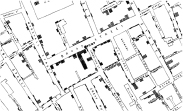
Physician John Snow convinces London authorities to remove a pump handle. A deadly cholera epidemic comes to an end immediately, though perhaps serendipitously. Snow maps the outbreak to prove his point… and launches modern epidemiology.
Snow had published On the Mode of Communication of Cholera in 1849. His data showed the disease was spread by sewage pollution in drinking water. The work went largely ignored by the medical establishment, which blamed miasma, or bad air.

Cholera broke out in London’s Soho district in 1854, killing 127 in the first three days of September. Three-quarters of Soho’s population fled. Snow lived in the district and interviewed victims’ families. Almost all lived near the Broad Street water pump. Streets nearer another pump had fewer fatalities. Snow examined water from Broad Street under a microscope (see here) and found “white, flocculent particles.” Local authorities weren’t convinced their water was polluted, but they were desperate enough to try shutting the pump down. With the handle removed, people couldn’t draw water from the subterranean cause of home-sick blues. The pump don’t work ’cause the council took the handle.
Numbers of new cases dropped almost immediately, but the epidemic had already been subsiding. It turned out, however, that three cholera patients who lived elsewhere had in fact drunk from the infected pump. Few local people who drank from a different well got sick, nor did brewery workers who drank free beer instead of water. The cause was positively Broad Street.
It was soon traced to a single source: a cholera-infected baby whose diaper wash was emptied in a cesspool that leaked directly into the well. Over six hundred people died.
Snow’s maps illustrating the distribution of cholera cases relative to the pump are a milestone in the study of the geography of disease. Edward Tufte cites them in Visual Explanations.—RA